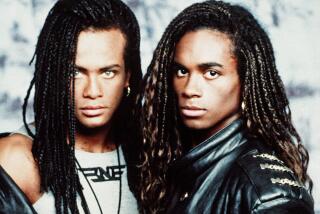Demi Lovato’s rebirth

TRANSFORMATION: Former Disney teen star
- Share via
There was always an excuse — a friend to see, a meeting to take, sleep to catch up on.
Only a year ago, Demi Lovato was one of Disney’s most bankable teen stars, her every move scrutinized by a team of attentive handlers. Yet when an eating disorder and self-mutilation threatened to derail her career, not even her team could see past her sanguine veneer.
“I had learned how to control and manipulate everyone around me into believing that I was OK,” recalled Lovato, who rose to fame as the star of the popular Disney Channel series “Sonny With a Chance.” “I’d go to work on my TV show and, instead of getting lunch, I would go get my nails done or go tan or nap or something.... No one was grilling me.”
But last October, Lovato’s cover was finally blown. While on an international concert tour with the Jonas Brothers, she unexpectedly punched a backup dancer in the face. (The explanation behind the physical altercation remains unclear, though a suit brought by the dancer was settled for an undisclosed amount in December.) Lovato’s management team — at the time it included Kevin Jonas Sr., the father of the Jonas Brothers — intervened, which was when the extent of her personal issues apparently came fully to light.
Accordingly, Lovato dropped off the tour and checked into Timberline Knolls, a residential treatment center outside Chicago.
While many Mouse House stars might have avoided the spotlight after such a public meltdown, Lovato instead has been surprisingly candid about her struggles. Since emerging in January after three months in rehab, she has been open about her problems, which include bulimia and bipolar disorder.
That 12-month journey culminates, she says, in “Unbroken,” her third studio album, which was released Tuesday and immediately shot to No. 1 on iTunes. She’ll play a sold-out show at the Nokia Theatre on Friday.
The singer has begun to stray from her airy pop-rock roots on “Unbroken,” which has more of an R&B influence and includes collaborations with Timbaland, Missy Elliott and Jason Derulo. Not that anyone seems to be paying much mind to Lovato’s musical growth. Instead, the album serves as the most tangible representation of her transformation from a perfect teen queen to an edgier young adult unafraid to flaunt her flaws.
Her look has changed too: Gone are the precious matching sweater sets she once donned on her TV program, a relatively makeup-free face and a toothy grin. That is the Lovato still framed on the wall at Hollywood Records, where the singer’s latest album cover hangs near those of her once-equally clean-cut tween cohorts Selena Gomez and Hilary Duff. Lovato was holed up at the label’s headquarters for a few hours last week to do promotional work for “Unbroken.” When she walked into one of the building’s nondescript conference rooms, she was flanked by two members of her team, including her stepfather-turned-manager, Eddie De La Garza.
Though Lovato is now of legal age and no longer under the critical eye of the Disney Channel, she is in many ways more supervised than ever. After every meal, she checks in with an adult who makes sure she is eating properly.
“Sometimes, I still think to this day, ‘I wish I wasn’t so watched,’” she said, glancing at her management team and appearing to make sure she wasn’t going off-book.
Lovato has gained weight since exiting treatment — about 30 pounds, she says. Last week, her figure was largely hidden under an amalgamation of black clothing and layered necklaces. She was tan, had on thick eyeliner and appeared to be wearing voluminous hair extensions.
Already, there has been public snarking about her new appearance. After she wore a body-conscious dress at the MTV Video Music Awards last month, her Twitter account was inundated with hateful comments about her weight.
That kind of judgment was in part why, after treatment, Lovato decided to quit her lucrative television show.
“I just felt that being on camera for my first job wasn’t the smartest decision,” she said. “On TV, you have wardrobe fittings, you have four cameras on you at all times, and you’re worried about your angles and your lighting and your shots.”
Such self-scrutiny evaded Alan Sacks, executive producer of two of Lovato’s successful TV movies with the Jonas Brothers, “Camp Rock” and its sequel.
“I was never aware of anything going on regarding her weight,” Sacks said. “She never showed anything to me other than love and joy.”
It remains to be seen whether Lovato’s dramatic personal life will eclipse her shot at a legitimate adult music career. She certainly has plenty of support within Hollywood.
“Even though she was going through a difficult time last year, she put herself in an even more vulnerable position by opening up and sharing that part of her journey with her fans,” Lovato’s new friend Kim Kardashian wrote in an email.
On “Unbroken,” Lovato holds little back. One song, “For the Love of a Daughter” — initially slated for release on her last album — has a 4-year-old Lovato pleading with her father to “put the bottle down” and questioning, “How could you … put your hands on the ones that you swore you loved?”
“A few years ago, when I was with the Disney Channel, I didn’t want parents having to explain to their children the depth of the lyrics,” Lovato said somewhat dismissively, seeming reluctant to delve into more emotional territory.
For years, Lovato was able to hide the pain stemming from her upbringing. When she first recorded her current single, “Skyscraper,” over a year ago, she felt so disconnected from the song’s uplifting message that she doubled over in the studio, sobbing. “People just thought I was really into the song,” she shrugged.
At the time, Lovato was forcing herself to vomit after eating, which damaged her vocal cords; she blamed the raspiness on acid reflux.
After treatment, Lovato rerecorded the single but ultimately opted to put the original version on “Unbroken.”
“My voice is different now, but there just wasn’t that same spark,” she said. “I wanted to come out of the gate with this song, because a lot of people were expecting me to talk about what I’ve been through the past year. I want my music to do the explaining.”
More to Read
The biggest entertainment stories
Get our big stories about Hollywood, film, television, music, arts, culture and more right in your inbox as soon as they publish.
You may occasionally receive promotional content from the Los Angeles Times.










